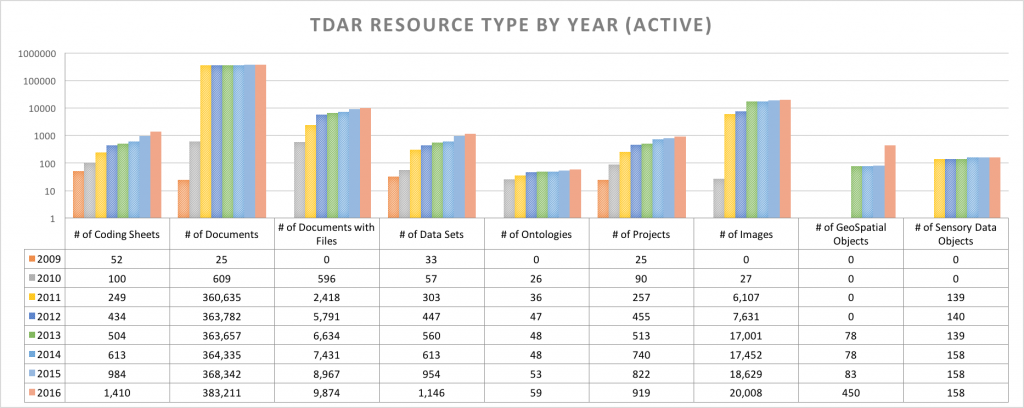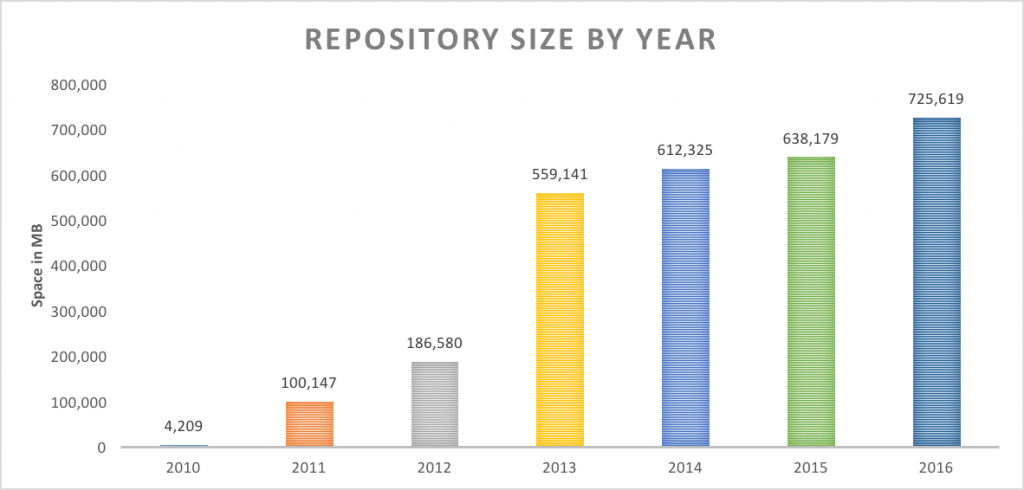We had a busy year at the Center for Digital Antiquity in 2016, tDAR continued to grow with significant contributions from the North Atlantic Biocultural Organization , US Air Force, and US Army Corps of Engineers. tDAR had one major software releases, Obsidian which focused on enhancing the collections pages, searching, data integration, and added new APIs for working with data and metadata in tDAR.
We are continuing our work with the Corps of Engineers Veterans Curation Program, putting digital products based on their rehabilitation of physical archaeological collections into tDAR where it can be shared broadly. We worked with the US Air Force cultural heritage program as program leaders there continued to build digital archaeological archives for their bases and other facilities. We are also still working with the Phoenix Area Office of the Bureau of Reclamation on their rich archives of archaeological material.
Individual researchers and research organizations began or continued to build their archives in tDAR. A few notable contributions include those from: the Eastern Mimbres Archaeological Project (EMAP) , the ICOM Affiliated Organisation representing archaeological open-air museums, experimental archaeology, ancient technology, and interpretation (EXARC), the PaleoResearch Institute, the Center for Archaeology and Society, SRI Press, and the Dainzú-Macuilxóchitl Archaeological Project. Also notable was an extensive set of tree-ring data uploaded by Tim Kohler and Kyle Bocinsky.
As part of our continuing agreements with Archaeological Institute of America (AIA) and Society for American Archaeology (SAA), we ran workshops highlighting best practices in digital curation at the AIA annual meetings in Orlando and San Francisco respectively. We also continue to provide SAA student members with a number of no cost uploads for contributing their data to tDAR as part of our agreement with SAA.
We continued our existing partnerships with the DataARC and SKOPE NSF awarded projects. We also developed new international partnerships for the use of tDAR by colleagues and organizations in Australia with the Federated Archaeological Information Management System (FAIMS) and in Canada with Sustainable Archaeology at the University of Western Ontario and the Museum of Ontario Archaeology.
Content added to tDAR in 2016
Usage Statistics
While we do not maintain detailed statistics on users or use to protect user and contributor privacy, we can share some interesting aggregate data. Below are the most frequently viewed and downloaded resources.
Resources (most viewed)
- Mimbres Pottery Images Digital Database (MimPIDD) (8467)
- Prehistoric Irrigation in Arizona: Symposium 1988 (5329)
- Food Crisis in Prehistory: Overpopulation and the Origins of Agriculture (3404)
- Aztec Ruin Dendro Data (2820)
- Koster Site (2350)
- Jordan’s Journey (44PG302) (2207)
- Standards for Data Collection from Human Skeletal Remains (2100)
- Culture and Commitment: a Study of the Generation Gap (1687)
- Eaton Site (1529)
- Fauna Taxon Ontology – TAG (UK) (1443)
- AZ-3128 (1425)
- Outdated: Fauna Taxon – Southwest US Ontology (3028) (1406)
- The Archaeology of Highland Chiriqui, Panama — Documents, Images, and Datasets (1397)
- Fauna Taxon Ontology – Eastern US (Outdated) (1306)
- Aztec West Ruin: Perishable Artifacts and Pottery from Excavations by the American Museum of Natural History (1188)
- Iroquoian Ceramic Data (1174)
- Sapelo Island (1110)
- Bryan Site: a Prehistoric Village In Southern Minnesota (1100)
- Spitalfields Project (1078)
- Archaeological Impact Evaluation of the Proposed Stone Bridge Ranch Development, Napa County, California (1073)
Resources (most Downloaded)
- Archeological Investigations at Joshua Tree National Park, California (202)
- Exploring Iran: The Photography of Erich F. Schmidt, 1930-1940, Supplementary Material (166)
- Grand Challenges for Archaeology – Crowd Sourcing Report (142)
- Petroglyphs of the Picacho Mountains, South Central Arizona (122)
- A Gazetteer of Excavated Hohokam Sites on Canal System Two, Phoenix Basin, Arizona (118)
- Tikal Report 11: Georeferenced Map- “Ruins of Tikal” (with border) (116)
- Hohokam Population Database (112)
- A Century of Archeological Research at Mesa Verde National Park (112)
- Archaeological Excavations at Jordan’s Point: Sites 44PG151, 44PG300, 44PG302, 44PG303, 44PG315, 44PG333 (102)
- An Overview and Assessment of Middle Verde Valley Archeology (100)
- The Archeology of Gila Cliff Dwellings (97)
- Frank Midvale’s Investigation of the Site of La Ciudad (97)
- Mimbres Pottery Database (Public) (95)
- Part 3: Quiriguá Wider Periphery, Additional Illustrations and Tables (95)
- Archaeology of the Pueblo Grande Platform and Surrounding Features Volume 2 Features in the Central Precinct of the Pueblo Grande Community (95)
- Humboldt County 1947-1948 Aerial Photo Index Table (91)
- The Operation and Evolution of an Irrigation System: The East Papago Canal Study (89)
- Death, Society and Ideology in a Hohokam Community: Colonial and Sedentary Period Burials from La Ciudad (88)
- The 1982-1984 Excavations at Las Colinas: Material Culture (87)
- The Importance of Plow Zone Archaeology (87)
Culture Keywords (most used)
- Norse (371)
- Hohokam (142)
- Mogollon (127)
- Ancestral Puebloan (120)
- Perry Mesa Tradition (100)
- Historic (29)
- Archaic (27)
- Late Archaic (21)
- Mimbres (20)
- Patayan (17)
- Euroamerican (15)
- Historic Native American (12)
- Middle Archaic (12)
- Yuman (12)
- PaleoIndian (8)
- Late Woodland (8)
- Woodland (7)
- Early Archaic (7)
- Middle Woodland (6)
- Zuni (6)
Investigation Type (most used)
- Data Recovery / Excavation (517)
- Collections Research (452)
- Systematic Survey (178)
- Heritage Management (142)
- Archaeological Overview (139)
- Reconnaissance / Survey (120)
- Site Stewardship Monitoring (102)
- Remote Sensing (101)
- Methodology, Theory, or Synthesis (46)
- Site Evaluation / Testing (39)
- Research Design / Data Recovery Plan (25)
- Records Search / Inventory Checking (23)
- Architectural Survey (20)
- Architectural Documentation (13)
- Historic Background Research (12)
- Bioarchaeological Research (12)
- Environment Research (10)
- Ethnographic Research (7)
- Ethnohistoric Research (7)
- Geophysical Survey (4)
Site Type (most used)
- Domestic Structure or Architectural Complex (713)
- Artifact Scatter (45)
- Archaeological Feature (33)
- Domestic Structures (32)
- Resource Extraction/Production/Transportation Structure or Features (29)
- Funerary and Burial Structures or Features (27)
- Settlements (27)
- Non-Domestic Structures (23)
- Room block / compound / pueblo (23)
- Midden (23)
- House (23)
- Hearth (23)
- Hamlet / village (21)
- Pit (21)
- Trash midden (20)
- Water control feature (19)
- Agricultural or Herding (19)
- Canal or canal feature (16)
- Encampment (16)
- Town / city (16)
Material Type (most used)
- Chipped Stone (110)
- Ceramic (104)
- Ground Stone (80)
- Fauna (76)
- Shell (60)
- Macrobotanical (58)
- Dating Sample (52)
- Metal (45)
- Mineral (32)
- Wood (31)
- Glass (29)
- Human Remains (27)
- Building Materials (27)
- Pollen (25)
- Sediment (15)
- Fire Cracked Rock (14)
- Obsidian (12)
- Charcoal (9)
- Turquoise (5)
- Redware (5)
Geographic Keywords (most used)
- Germany (1553)
- USA (982)
- Denmark (689)
- Iceland (604)
- England (576)
- Sweden (534)
- France (494)
- Scotland (462)
- Wales (461)
- North Atlantic (460)
- Mesoamerica (452)
- NORTHERN IRELAND (440)
- the Netherlands (439)
- ITALY (378)
- South America (377)
- Spain (336)
- Greece (308)
- Czech Republic (296)
- Norway (291)
- Poland (277)
Temporal Keywords (most used)
- Iron Age (1869)
- Neolithic (1742)
- Newest Era (1608)
- Palaeolithic (1430)
- Bronze Age (1301)
- Chalcolithic (1286)
- Mesolithic (1236)
- Early Middle Ages (1195)
- Roman Era (956)
- Late Middle Ages (787)
- Newer Era (524)
- Viking Age (371)
- Viking Age/Early Medieval (326)
- Late Chaco (175)
- Classic Period (109)
- Perry Mesa Tradition (100)
- Late Classic Period (99)
- Pueblo III Period (98)
- Pueblo IV period (98)
- Early Chaco (66)
Other Keywords (most used)
- archaeological open-air museum (1149)
- construction of building (1076)
- Ethnoarchaeology (994)
- Ceramic (801)
- Education (736)
- stone (706)
- boat or ship (596)
- Iron (530)
- Experiment (510)
- Textile (483)
- Tools (477)
- Smelting (460)
- Use Wear Analysis (435)
- Museum (393)
- Weapon (389)
- Agriculture (329)
- knapping (320)
- Bone (300)
- bronze (266)
- Metal (241)
People (most used)
- Aaron Kendall (2318)
- David Wescott (930)
- Kyle Bocinsky (366)
- Mamoun Fansa (347)
- Roeland P Paardekooper (283)
- Tomas Johansson (253)
- Radomír Tichý (247)
- Jeroen P Flamman (166)
- Errett Callahan (135)
- J. Kateřina Dvořáková (129)
- Peter J Reynolds (127)
- Javier Baena Preysler (122)
- Will Russell (117)
- Rüdiger Kelm (103)
- Hana Dohnálková (85)
- Sarah Klassen (81)
- David E Johnston (77)
- Antoni Palomo (73)
Institutions (most used)
- Experimental Archaeology (11625)
- US Army Corps of Engineers Mandatory Center of Expertise for the Curation and Management of Archaeological Collections, St. Louis District (113)
- US Army Corps of Engineers, Louisville District (111)
- Veterans Curation Program (76)
- Legacies on the Landscape Project, Arizona State University (76)
- USDI Bureau of Reclamation, Phoenix Area Office (58)
- National Air Survey Center Corporation (Bladensburg, MD) (53)
- Applied Archaeology Laboratories, Ball State University (49)
- PaleoResearch Institute (34)
- Arizona State University (ASU) (28)
- Brockington and Associates, Inc. (26)
- USDI Bureau Reclamation, Phoenix Area Office (23)
- Bureau of Land Management (16)
- Arizona State University, Department of Anthropology (15)
- Bureau of Reclamation, Phoenix Area Office (15)
- Office of Cultural Resource Management, Department of Anthropology, Arizona State University (14)
- Glenn A. Black Laboratory of Archaeology, Indiana University (13)
- U.S Army Corps of Engineers, Louisville District (11)
- SUNY ALBANY (10)
- Archaeological Consulting Services Ltd. (7)

